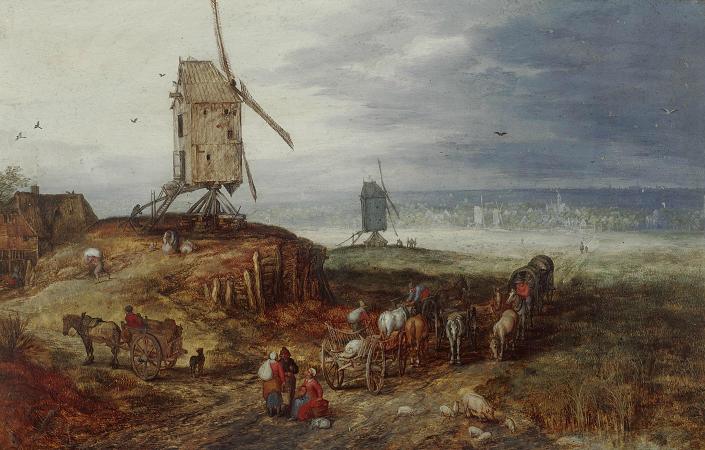Landscape with Windmill. A windmill is a structure that converts wind power into rotational energy by means of vanes called sails or blades,specifically to mill grain, but the term is also extended to windpumps, wind turbines and other applications. Windmills were used throughout the high medieval and early modern periods; the horizontal or panemone windmill first appeared in Greater Iran during the 9th century, the vertical windmill in northwestern Europe in the 12th century. Hero of Alexandria in first-century Roman Egypt described what appears to be a wind-driven wheel to power a machine. His description of a wind-powered organ is not a practical windmill, but was either an early wind-powered toy, or a design concept for a wind-powered machine that may or may not have been a working device, as there is ambiguity in the text and issues with the design. Another early example of a wind-driven wheel was the prayer wheel, which is believed to have been first used in Tibet and China, though there is uncertainty over the date of its first appearance, which could've been either circa 400, the 7th century, or after the 9th century. Main article: Panemone windmill Further information: Vertical axis wind turbine The first practical windmills were panemone windmills, using sails that rotated in a horizontal plane, around a vertical axis. Made of six to 12 sails covered in reed matting or cloth material, these windmills were used to grind grain or draw up water. These windmills are recorded by Persian geographer Estakhri in the 9th century as being operated in Khorasan. The authenticity of an earlier anecdote of a windmill involving the 7th-century caliph Umar is questioned on the grounds that it is recorded only in the 10th centrury. Such windmills were in widespread use across the Middle East and Central Asia, and later spread to Europe, China and India from there.By the 11th century, the vertical-axle windmill had reached parts of Southern Europe, including the Iberian Peninsula and the Aegean Sea. A similar type of horizontal windmill with rectangular blades, used for irrigation, can also be found in thirteenth-century China, introduced by the travels of Yelü Chucai to Turkestan in 1219. Vertical-axle windmills were built, in small numbers, in Europe during the 18th and nineteenth centuries, for example Fowler's Mill at Battersea in London, and Hooper's Mill at Margate in Kent. These early modern examples seem not to have been directly influenced by the vertical-axle windmills of the medieval period, but to have been independent inventions by 18th-century engineers. The horizontal-axis or vertical windmill is a development of the 12th century, first used in northwestern Europe, in the triangle of northern France, eastern England and Flanders.It is unclear whether the vertical windmill was influenced by the introduction of the horizontal windmill to Southern Europe in the preceding century. The earliest certain reference to a windmill in Northern Europe dates from 1185, in the former village of Weedley in Yorkshire which was located at the southern tip of the Wold overlooking the Humber Estuary. A number of earlier, but less certainly dated, 12th-century European sources referring to windmills have also been found.These earliest mills were used to grind cereals. Main article: Post mill The evidence at present is that the earliest type of European windmill was the post mill, so named because of the large upright post on which the mill's main structure is balanced. By mounting the body this way, the mill is able to rotate to face the wind direction; an essential requirement for windmills to operate economically in north-western Europe, where wind directions are variable. The body contains all the milling machinery. The first post mills were of the sunken type, where the post was buried in an earth mound to support it. Later, a wooden support was developed called the trestle. This was often covered over or surrounded by a roundhouse to protect the trestle from the weather and to provide storage space. This type of windmill was the most common in Europe until the 19th century, when more powerful tower and smock mills replaced them. In a hollow-post mill, the post on which the body is mounted is hollowed out, to accommodate the drive shaft.This makes it possible to drive machinery below or outside the body while still being able to rotate the body into the wind. Hollow-post mills driving scoop wheels were used in the Netherlands to drain wetlands from the 14th century onwards. Main article: Tower mill By the end of the 13th century, the masonry tower mill, on which only the cap is rotated rather than the whole body of the mill, had been introduced.
more...














